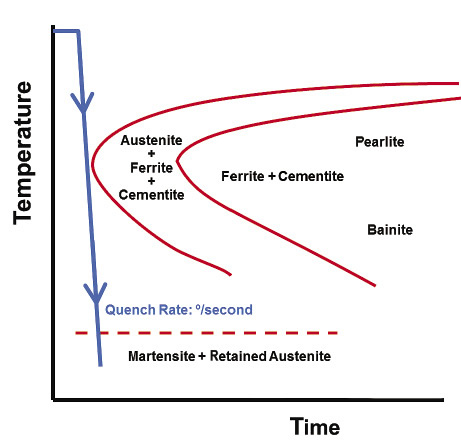Dear Doc: Our supplier in Asia is grinding hardened-steel parts and sending them to us for final processing. Some of them are cracking, so we’re going to visit the supplier. What should we be looking for?
The Doc Replies: Typically, there are two possible causes for cracks. The first is that grinding temperatures are too high, causing residual tensile stresses, rehardening phase transformation or both. This can lead to immediate cracking or cracking when the part is in the field. To confirm, check ground parts for white layer via sectioning and nital-etching, as well as residual tensile stresses via X-ray diffraction. To stop the cracking, lower the grinding temperatures with sharper dressing or use better grinding parameters.
The second possibility is that the workpiece material was “messed up” before it was ground. This is where the solution can get tricky. The material, prior to heat treatment, may contain flaws, such as pores, cracks and inclusions.
Heat treatment can also cause material to become “sensitive” to cracking, even when grinding temperatures are low. Bad heat treatment often occurs when tempering times are too short, temperatures are not low enough between tempers or when quenching occurs too slowly. This results in strange phases in the material, such as bainite.


One cause of workpiece sensitivity with steel parts is a quench rate that's too low during heat treatment, resulting in unwanted phases, such as bainite, pearlite or ferrite. Illustration courtesy J. Badger.

Before visiting the supplier, pray to the grinding gods that it’s high grinding temperatures causing the cracking, because this can be readily solved. If it’s material sensitivity, you’re in for an adventure. Projects investigating cracking because of material sensitivity can take months to resolve and still yield ambiguous results.
A typical scenario: Parts from your supplier are cracking, so you visit and see that they are getting rehardening burn during grinding. You fix the grinding problem, and the rehardening burn goes away. You go home, but parts occasionally continue to crack. So you go back and see the grinding is still OK—at least during your visit. This time, though, you bring a metallurgist, who examines the supplier’s heat-treatment practices and says they look good—at least during your visit.
Back at your shop, parts occasionally continue to crack, and the metallurgist analyzes a part with cracks, but sees good heat treatment and good grinding. He looks deeper and determines the material had become embrittled before heat treatment. He then visits the material supplier. A year later the investigation continues. If you face this scenario, find a good metallurgist, find a knowledgeable grinder and find some patience.
Related Glossary Terms
- dressing
dressing
Removal of undesirable materials from “loaded” grinding wheels using a single- or multi-point diamond or other tool. The process also exposes unused, sharp abrasive points. See loading; truing.
- ferrite
ferrite
Solid solution of one or more elements in body-centered cubic iron. Unless otherwise designated, for instance, as chromium ferrite, the solute is generally assumed to be carbon. On an equilibrium diagram, there are two ferrite regions separated by an austenite area. The lower area is alpha ferrite and the upper area is delta ferrite. If there is no designation, alpha ferrite is assumed. Not more than 0.04 percent carbon can be dissolved in alpha iron. Ferrite is stable below 1,670º F (910º C); it is soft, highly ductile, and magnetic. Ferrite loses its magnetic property above 1,414º F (768º C).
- grinding
grinding
Machining operation in which material is removed from the workpiece by a powered abrasive wheel, stone, belt, paste, sheet, compound, slurry, etc. Takes various forms: surface grinding (creates flat and/or squared surfaces); cylindrical grinding (for external cylindrical and tapered shapes, fillets, undercuts, etc.); centerless grinding; chamfering; thread and form grinding; tool and cutter grinding; offhand grinding; lapping and polishing (grinding with extremely fine grits to create ultrasmooth surfaces); honing; and disc grinding.
- pearlite
pearlite
Lamellar aggregate of ferrite and cementite in slowly cooled iron-carbon alloys occurring normally as a principle constituent of steel and cast iron. Fully annealed steel containing 0.85 percent carbon consists entirely of pearlite.
- phase transformation
phase transformation
Heat generated by machining action that causes changes in the workpiece’s surface layers. This can result in softer- or harder-than-desired workpiece surfaces, as well as undesirable changes in cutting tools.
- quenching
quenching
Rapid cooling of the workpiece with an air, gas, liquid or solid medium. When applicable, more specific terms should be used to identify the quenching medium, the process and the cooling rate.
- tempering
tempering
1. In heat-treatment, reheating hardened steel or hardened cast iron to a given temperature below the eutectoid temperature to decrease hardness and increase toughness. The process also is sometimes applied to normalized steel. 2. In nonferrous alloys and in some ferrous alloys (steels that cannot be hardened by heat-treatment), the hardness and strength produced by mechanical or thermal treatment, or both, and characterized by a certain structure, mechanical properties or reduction in area during cold working.


 ARTICLES
ARTICLES



